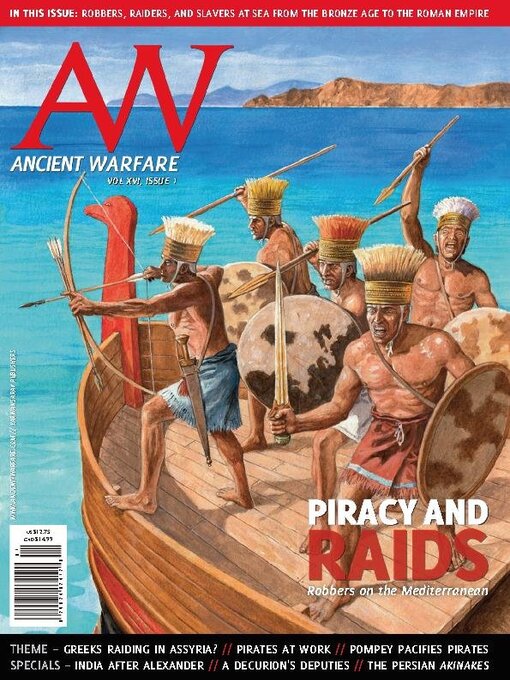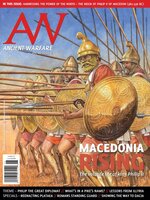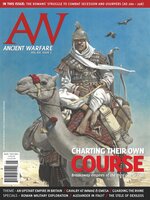Ancient Warfare is a unique publication focused exclusively on soldiers, battles, and tactics, all before 600 AD. Starting with ancient Egypt and Persia and continuing to the fall of the Western Roman Empire, Ancient Warfare examines the military history of cultures throughout Europe, the Middle East and parts of Asia and Africa. Ancient Greece and Rome receive the most frequent coverage, due both to the wealth of contemporary sources and the modern fascination with these two great civilizations. Subject-matter ranges from the familiar to the more obscure: while Alexander the Great, the Persian Wars and Caesar’s Gallic campaigns all receive regular coverage, Ancient Warfare also looks at some of the less common parts of ancient military history, from chariots as battle taxis to PTSD in antiquity.
Ancient Warfare Magazine
PRELIMINARIES NEWS ITEMS
Metal 'fingerprint' confirms Clades Varian
Watchtower found on Rome's southern border
How an auxiliary unit blew its own trumpet
One of Britain's longest Roman inscriptions goes on display
Foreign soldiers of a classical greek army revealed in their genes
HAVE YOU READ?
FIGURING OUT BRONZE AGE PIRACY OPPORTUNIST RAIDERS • Understanding piracy at the end of the Bronze Age is fraught with controversy. There is no contemporary word for the concept, yet archaeological evidence and even some minimal textual references make it possible to speak of piratical activity in the Late Bronze Age. Numerous discussions of ancient seaborne tribes collectively referred to as 'Sea People' in modern studies frequently describe them as raiders or pirates. That said, applying the label does not replace an explanation of what it meant to be a pirate in the twelfth century BC.
GREEK PIRATES IN THE EIGHTH-CENTURY LEVANT? THE IAUNA HAVE COME • In the late eighth century BC, the Assyrian governor of Phoenicia, Qurdi-Aššurlamur, wrote to Tiglath-Pileser III of a seaborne raid upon a place called Danabu. These raiders, the launa, are thought to be lonian Greeks. While this identification is not definite, raiding was certainly important to Iron Age Greek culture.
CLASSICAL AND HELLENISTIC GREEK PIRACY THE PIRATE CREW AT WORK • When northern Europeans and North Americans think of piracy, the cultural blueprint that comes quickly to mind is that of piracy in the Early Modern Caribbean. However, Caribbean piracy is rather a misleading analogy when it comes to approaching ancient Greek piracy, at least in its earlier phases. A better analogy is Viking raiding of the early Middle Ages. Here, longship-owning elites who dominated society crewed their ships with followers bonded to them by reciprocal obligations and went roving abroad for summer slaving and plundering raids, but also settled new lands.
JULIUS CAESAR AND THE CILICIAN PIRATES THEY THOUGHT HE WAS JOKING • Just into his twenties, Julius Caesar was captured and ransomed by pirates. The kidnapping did not turn out the way his renegade maritime captors had planned.
POMPEY AND THE PIRATES ANTI-PIRACY IMPERIALISM • In 67 BC, one of the Roman Republic's leading generals, Gnaeus Pompeius Magnus, Pompey the Great, was given an extraordinary, three-year, Mediterranean-wide command by a law of the Roman people, to rid the seas of 'pirates'.
WARS OF THE MAURYAN EMPIRE IN THE WAKE OF ALEXANDER • The shock of the Macedonian invasion of northwestern India exposed the weaknesses of divided tribal states and small kingdoms. When the army of Alexander left, a network of satraps and vassals remained. The chaos after his death reached all the way to India and allowed a driven sage and his chosen pupil to create an empire that stretched across most of the subcontinent and lasted into the second century BC.
FURTHER READING
AN EMBLEM OF DISTINCTION THE PERSIAN AKINAKES • By...

 AW XVII.2
AW XVII.2
 AW XVII.1
AW XVII.1
 AW XVI.6
AW XVI.6
 AW XVI.5
AW XVI.5
 AW XVI.4
AW XVI.4
 AW XVI.3
AW XVI.3
 AW XVI.2
AW XVI.2
 AW XVI.1
AW XVI.1
 AW XV.6
AW XV.6
 AW XV.5
AW XV.5
 AW XV.4
AW XV.4
 AW XV.3
AW XV.3
 AW XV.2
AW XV.2
 AW XV.1
AW XV.1
 AW XIV.6
AW XIV.6
 AW XIV.5
AW XIV.5
